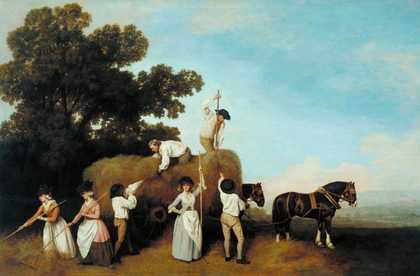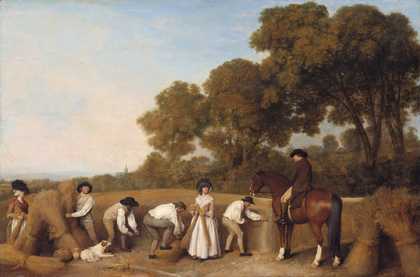These are very careful compositions developed through previous paintings and sketches. To me, the stillness and lack of complication feel similar to a documentary film approach where the camera has a fixed pose. I am aware that there is always a bias in any attempt at representation, however Stubbs’s paintings have a sense of achieving objectivity. They are enjoyable to enter into. There is room to be present as a viewer, and you recognise his inquiring mind and feel the space left to you through his attempt not to dominate as an author. I find Reapers and Haymakers more successful than one of his dramatic paintings, such as Horse Attacked by a Lion 1769.
They have a quality that is a product of Stubbs’s intense and unusual passion for (and ability to produce innovative engravings of) anatomy, which becomes more reasonable when you read that his father was a tanner, currier and leather merchant, and that he was brought up in this trade as an apprentice until the age of fifteen when his father died. After this he studied painting.
Stubbs had an unusual approach to being an artist. For example, his trip to Italy to research Greek and Roman culture in effect was to confirm his underlying conviction that nature is superior to any man-crafted imitation. He returned from Italy to embark on an intricate and ghastly endeavour. Renting a farmhouse in Horkstow, Lincolnshire, in 1756, he isolated himself from the village and set to work over eighteen months dissecting to produce the series of engravings that are now so famous. He doggedly reproduced each layer of the horse in accurate complete renderings. It is as if he saw the production of art as a scientific procedure. This is impressive to me, as the role of an artist is so often presented to be expressive and emotional without aim, rather than innovative and pioneering.
Apart from his c.1762 painting of the racehorse Whistlejacket (as well as his horses being attacked by lions), the animals Stubbs portrays are less emotional than most representations of animals in art, for example in the later work of Landseer. They do seem to express a sense of otherness, a difference from being human. Their domestication seems to be of note – that they are owned by the patron who has commissioned the work. I wonder whether the people working in Reapers and Haymakers are also being treated as if they were owned, and that I am being naive as to the objectivity of the observation and static quality of a moment in time.



